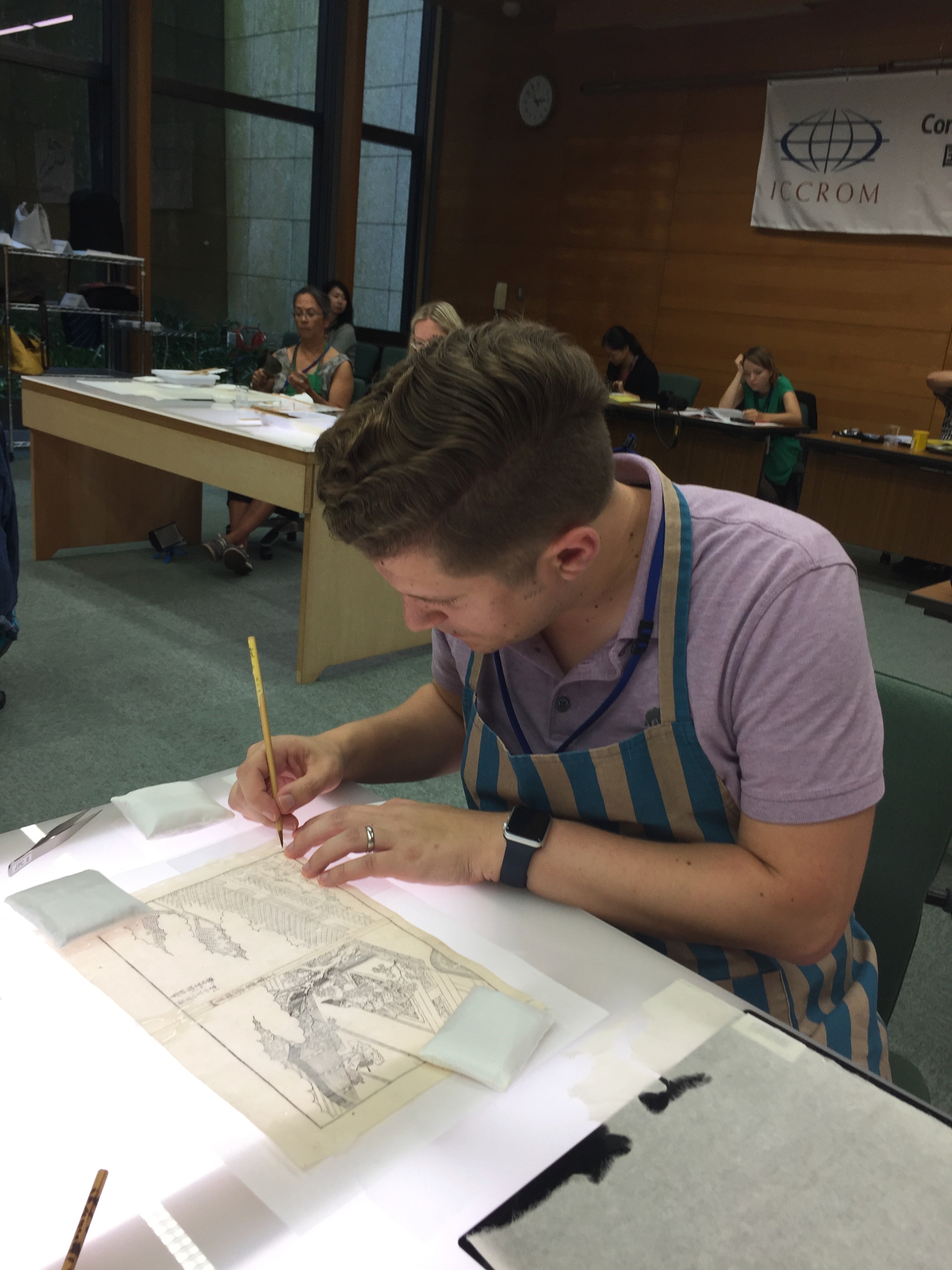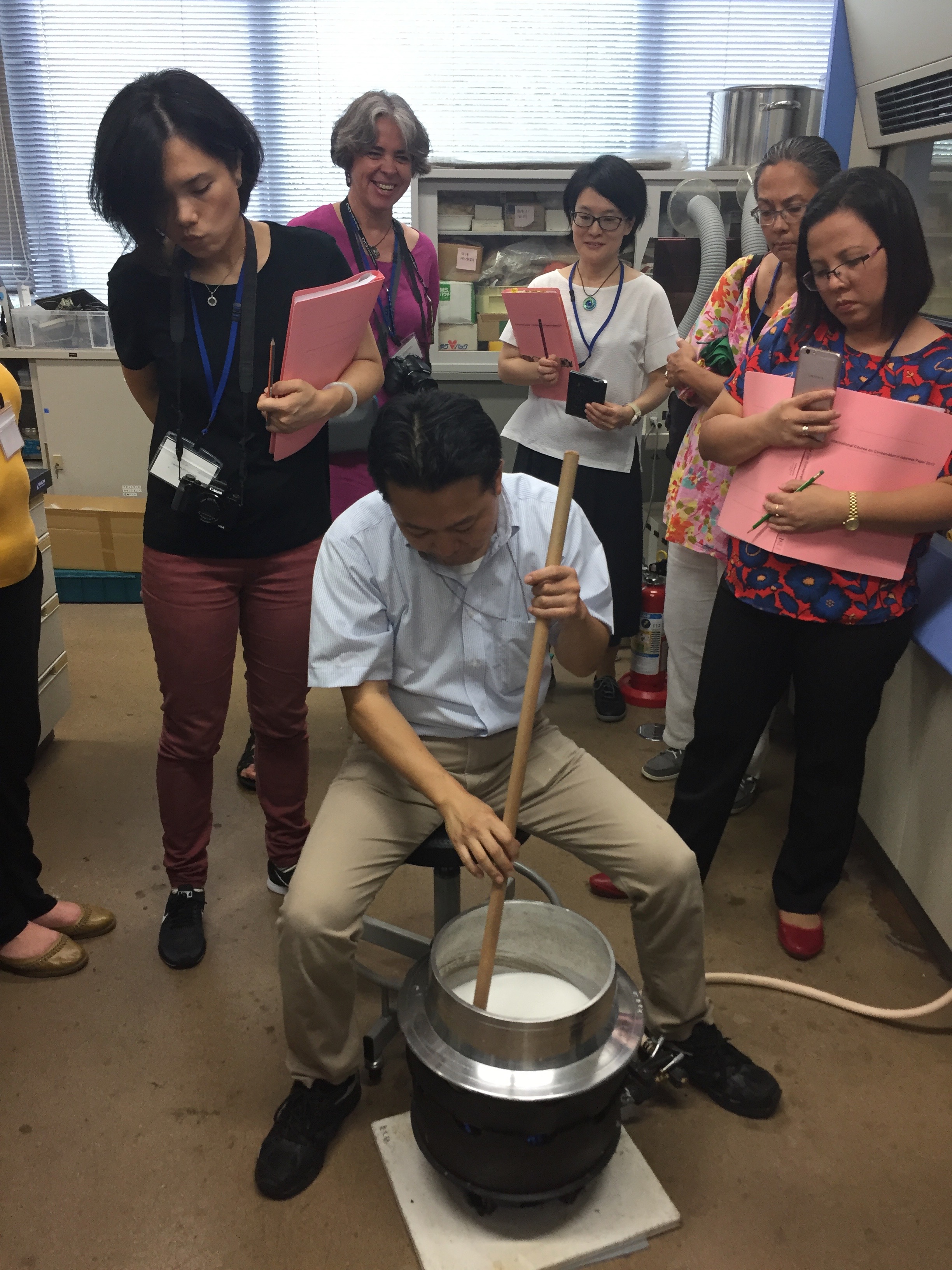Nearly two years ago, I first heard of a course on the conservation of Japanese paper co-organized by ICCROM, the cultural heritage arm of UNESCO, and the Tokyo National Research Institute for Cultural Properties (also known in Japanese as “Tobunken”). Over three weeks, the course offered a first-hand look at the traditional Japanese conservation techniques, materials, and approaches that inform modern paper conservation and which are taught in conservation training programs around the world. I determined to apply for the 2017 iteration of the course, and was thrilled to be accepted as one of ten participants from all over the world, including the Czech Republic, Latvia, Argentina, the Philippines, Israel, Greece, Australia, and China. Beginning at the end of August 2017 and continuing through the middle of September, we enjoyed an assortment of lectures, demonstrations, and practical work sessions.
Practical work
Much of modern paper conservation practice derives directly from traditional Japanese mounting techniques for their art forms on paper, such as paintings and calligraphy in various media. The most fundamental elements of this ancient practice are the use of cooked wheat starch paste as an adhesive and Japanese paper as a repair material. Our practical work sessions highlighted these two aspects of paper conservation by returning to their roots—each participant mounted a page from a printed Japanese book into a hand scroll. Each step was demonstrated by our expert practical instructors before we returned to our workbenches and practiced the techniques: cleaning and flattening the artwork; filling missing areas occasioned by insect damage; reinforcing areas that are likely to crease or crack when rolled with narrow strips of paper (called orefuse); applying various linings to strengthen and support the art; and fabricating the other elements of the scroll, including an indigo-dyed cover, a tail border paper that prevents the artwork from being too tightly rolled, and the wooden rod which the scroll rolls around.
Practical exercises were complemented by in-depth lectures on the science of pastemaking (itself accompanied by a grueling thirty minutes of stirring to achieve the right paste properties!), characteristics and identification of various Japanese papers, the making and maintenance of traditional brushes, and the proper care and handling of folding screens and hanging scrolls.
Study tour
While the first and third weeks were primarily concerned with our practical work sessions at Tobunken’s premises in Tokyo, during the second week we traveled in central Japan to visit the cities of Nagoya, Mino, and Kyoto. Along our route, we visited various conservation studios, tool and material shops, and historical sites, all to give us opportunities to interact with cultural heritage in a Japanese setting.
A true highlight of our travels was visiting Minotakekami Kobo, a traditional workshop specializing in Japanese Mino paper, named after its location, which has been prized for 1300 years and is designated a UNESCO intangible cultural heritage asset. After a demonstration and explanation of the process, a few of us, including me, were invited to try our hand (with assistance) at making a sheet of the Mino paper. It was thrilling to see and participate in making the paper, and the workshop was generous enough to gift me the sheet I made.
Our time in Kyoto also included a self-directed day, which permitted us to see some of Kyoto’s stunning cultural heritage, and even see preservation work-in-action at some of the sites. The stunning views of Kyoto from the picturesque Buddhist temple Kiyomizu-dera were matched by the massive scaffolding in place to stabilize the ancient main hall of the temple complex; the golden villa Ginkaku-ji surrounded by electronic concert equipment raised questions of the interplay between the needs of cultural heritage artifacts and the practical needs of a modern business that must financially sustain itself; and the magnificent 1,000 wooden statues of the bodhisattva Kannon in Sanjusangen-do temple seemed all the more precious for the care being taken by conservators as the sculptures were carefully cleaned and assessed for damage.
International experience
I trained as a conservator abroad, and was fortunate to have several opportunities to observe conservation in practice in different settings across Europe. Tobunken’s course in Tokyo provided not only a window into the practice of conservation in another area of the world, but a look at the roots of my own paper conservation knowledge. Learning from the source was a truly invaluable chance to deepen my understanding of the materials and techniques I use on a daily basis at the Archives. In addition, meeting other conservators from around the world was a priceless opportunity to learn from a variety of professional traditions, and share perspectives on cultural heritage and treatment of paper-based collections.
While the majority of my work is on Western paper, I was encouraged throughout the course to assess the applicability of what I was learning of the Japanese conservation approach to my own practice. I naturally do not mount archival documents onto handscrolls, but mend paper on a daily basis and have occasion to provide linings for stability and support (in fact, I have two projects in process that will both make use of my improved lining proficiency). And, should the need to care for Japanese or Asian artifacts in the future, I have the foundational expertise to see me through.
The seamless blend of tradition and modernity in Japanese culture is paralleled in Japanese conservation: thousands of years of ancient practices and artifacts coexist with modern innovations and technologies. In a similar way, having absorbed so much knowledge of the Japanese conservation tradition, I now can blend what I have learned with my previous skillset and go forward, better prepared to care for cultural heritage under my charge.
Related Resources
- “Japanese Paper Course Closes,” ICCROM.org
Produced by the Smithsonian Institution Archives. For copyright questions, please see the Terms of Use.














Leave a Comment